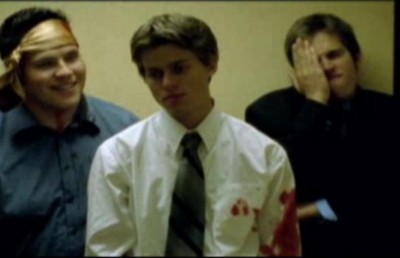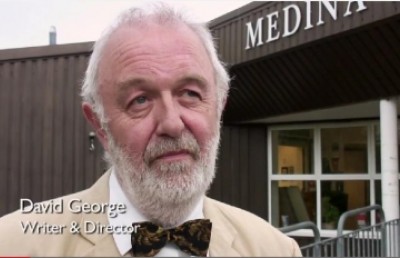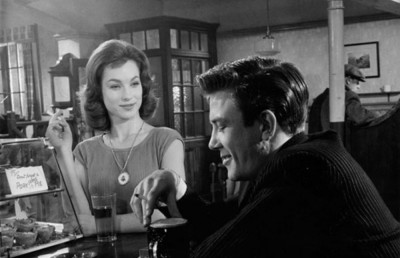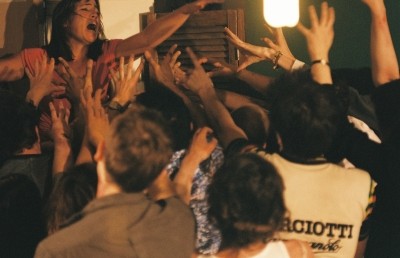The Descendant
Ghost Slaves of the Past
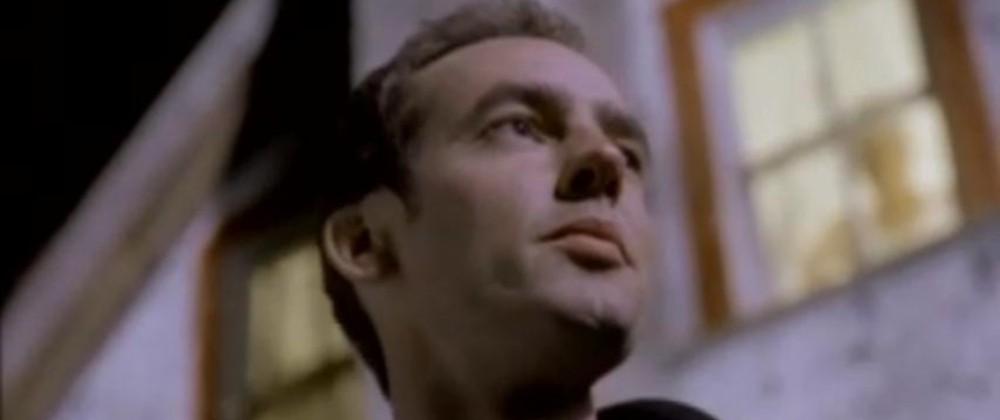
The Descendant
Production Team
Executive Producer: PHILIPPE CHABOT
Co-producer: DAVID RIGBY
Producer/Director: PHILIPPE SPURRELL
Written by : PHILIPPE SPURRELL & JOEL ASA MILLER
Cinematography: LORENZO NEGRI & IVAN GEKOFF (CSC)
Editor: ERIC LAVOIE
Music: DAVID KRISTIAN
Sound design: DAN LAGACE
Make-up FX: CJ GOLDMAN
Special Participation: SERGIO MACHADO
Readers should be warned that this analysis contains spoilers and is largely intended for readers who have seen the film.
Philippe Spurrell’s feature debut The Descendant (2007, Canada) is an intriguing mystery story revolving around a small Quebec community, and its shared secret past history, and how an outsider pushes those secrets to the surface, and in the process revealing how personal and social history can be intertwined.
Although the film was shot on 35mm, a rarity for low-budget filmmaking these days, this analysis is based on seeing the film digitally projected (at the 2006 Fantasia International Film Festival) in a setting that did not in any way detract from the lush images on the screen. Mr. Spurrell was available for a short Q and A after the show, and explained that he is still looking for funds to produce a 35mm theatrical print; the hope is that increasing interest in the film by Quebec historical scholars, film critics and/or professors will lead to an influx of funds required for a proper 35mm subtitled print (in French for the full Quebec market, since the film is spoken in English).
The story begins in Montreal with the thirty-something main protagonist, James (Tadhg MacMahon), finding a few details of his past via an old shoebox, left to him by his recently deceased mother; the shoebox is full of old photographs and birthday cards from his grandparents, whom he hasn’t had contact with since he was 3 years old. James is upset by the fact that the box contains dozens of cards addressed to him by his grandparents, but which he never received. James unearths one of his mother’s most “prized possessions,” a mouth harp, which will come back later in the film as an important prop. His partner, Kim, suggests that he should go and visit his grandparents to re-establish contact with his past, and possibly find answers to the reasons his mother exiled herself from her family. This plot element adds a layer of character identity quest to the more dominant theme of social history.
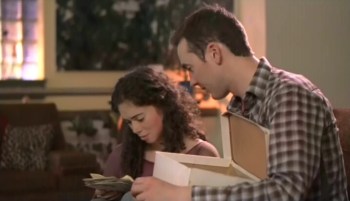
James with Kim
When James reaches the small isolated community of St-Harmonie, Quebec, he finds himself warmly welcomed by an old female friend of his mother’s, but looked on with suspicion by others in the local bar (a play on the classic stranger-heed-the-warning scene common to dozens of horror films, starting from Jonathan Harker’s inn respite on his travels to Dracula’s castle).
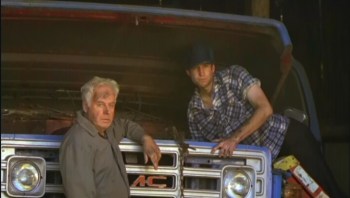
The ‘unwelcome’ party
James meets up with his grandparents Maurice (Jim Louis Reid) and Linda (Ilona Garcen) at their farm, and intends to stay for a few days to reacquaint himself with his family roots. He proceeds to unearth stories about his mother’s past, and finds secrets that the community collectively keeps buried deep in their history (a plot which recalls Mario Bava’s Kill Baby Kill, although to be fair to the director, Spurrell has always downplayed the film’s ‘horror’ elements in favor of its sociological import) .
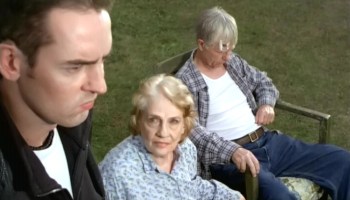
Props form an integral element of the film’s mood and theme, starting with the first item James notices when he enters the grandparents’ cottage: a gramophone that plays, to quote the grandfather, “those old scratchy 78 records” and, adds the grandmother tellingly, “helps keep the spirits away” (which oddly has the opposite effect in the film’s climax).
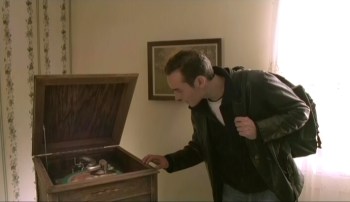
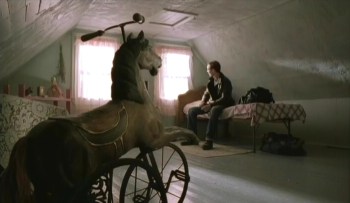
A slow point of view pan of James’ room reveals old relics from the past, including a rocking horse, another key prop, eerily represented in wide angle shots. A third key prop is an old quilt which James takes from the closet to use as a blanket on his first night. When the grandparents see that James is using the quilt, they seem a tad disturbed, and tell him that he is using “a real family heirloom,” knitted by matriarchs going back to the pre-Canada 1830s. Later when walking through the cornfields James discovers remnants of foot chains and bones amid the corn fields. The mouth harp returns in a brief black and white flashback with a younger Maurice preparing to take a photograph of a little girl (James’ mother) standing outside a barn. The sound of harp music emanating from the barn disturbs Maurice, who abruptly leaves his tripod for the barn (who is playing the harp, and why is Maurice so disturbed by its sound?). All of these (and other) props build up in James’ (and the audience’s) mind to the climactic revelation of the mystery (MAJOR SPOILER ALERT).
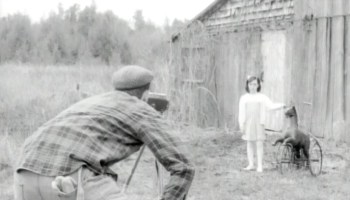
James places the gramophone outside near the corn fields, playing an old country blues slave song (a beautifully rendered recreation by composer extraordinaire, David Kristian) which summons, literally, the ghost slaves of the past. In a series of atmospheric slow motion night shots groups of African North American ghosts slumber out from the cornfields, an image that invokes not only the slumbering zombies of George Romero’s films but Jacques Tourneur’s poetic I Walked with a Zombie. The frightened grandparents take refuge in their farmhouse. Shadows of the ghosts crowd onto the grandparent’s front porch. James opens the front door to let in one of the ‘freed’ slaves, whom Linda recognizes and addresses by name, “Julius.” She hands over the quilt to the slave, a token of her (collective?) guilt.
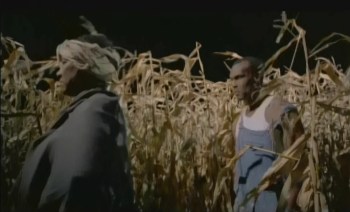
An homage to Val Lewton & Jacques Tourneur?
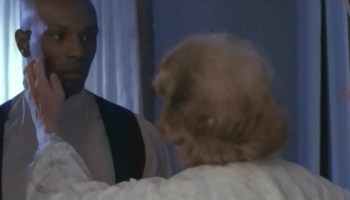
Julius and Linda
The audience discovers the film’s mystery –the community’s slave past– alongside James, whose investigation slowly unpeels layers of an historical past suppressed by the community. Interestingly, this dynamic reflects reality: the historical events depicted in the film were, up until only a few years ago, a relatively unknown part of Quebec’s own history (or known by only a select few). Canadians of course think of slavery as belonging to the history of their southern neighbors, the United States of America. Clearly slavery was never as wide-spread in the areas which would become Canada as in the United States, and many of the slave graves in Canada (of which four remain, one in the location which inspired this story, St. Armand, Quebec) are cemeteries for slaves who escaped from the United States into Canada and died as formerly enslaved African Americans.
According to Francois Remillard in the book Fabulous Quebec “The value of the historic site of the black-slave cemetery of Saint-Armand, in the Eastern Townships, has finally been recognized by the Québec government, which presented the municipality with a commemorative plaque in 2003. Known as “Nigger Rock,” the local landmark dates from the end of the 18th century.” And a few passages later, “…at the foot of an outcropping of slate known as “Nigger Rock,” a plot where black slaves were buried between 1794 and 1833” (p. 43).
The film acknowledges its historical pedigree with closing credit inter-titles which unroll while the camera slowly zooms in on the fictionalized black and white photograph of James’ mother as a four-year old girl sitting on the back of a slave (Julius). The inter-titles urge greater recognition for the slaves that “lay in an unmarked burial place known simply as ´Nigger Rock.´” The camera slowly zooms in to a close-up of the black slave, before it fades (appropriately enough) to black, giving the final ‘say’ to the slaves. Interestingly, especially given the film’s conscious anti-horror touches, this slow zoom-in to a close-up of a photograph instinctively reminded me of Roman Polanski’s psychological horror of personality classic, Repulsion, which ends with a slow zoom-in to the crazed looking eyes of the Catherine Deneuve character as a young girl!
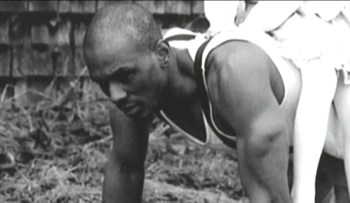
The cinematography by Lorenzo Negri and Ivan Gekoff (CSC) is quite sumptuous and serves the story well. The muted colours and close attention to the surface details and textures of the surroundings is very reminiscent of Kim Ki-Duk’s The Isle (the look of the farmhouse and the wood specifically). The art direction –for example, the costumes that were created for the inhabitants of the little community– literally transports the viewer to a past era, the film’s back-story dating back to the late 18th century, with trucks and vehicles being the only details of a vague contemporary setting once James is at the farm.
There are fabulous shots of the farm’s windswept cornfields that beg the question of how they were achieved with such a small budget. The actors delivered very convincing performances that at first glance appear off-kilter, but as the film progresses, become true for the characters involved; almost Lynchian in subtlety, especially the performance of the grandfather Maurice played by Jim Reid. For example, some lines are delivered by Reid with a certain exaggeration that in hindsight holds added significance. As when James asks his grandfather about the leather patches on the quilt, the grandfather tells James that the patches were “mementos” of farm horses that died over the years. When James notes that as being “one more thing I did not know about my family,” the grandmother turns to leave the room. The grandfather explains her curt departure by saying that she does not like to talk about the past because she is “a real animal lover” (a line he repeats on several occasions disguising the real significance of his words, “a real nigger lover”).
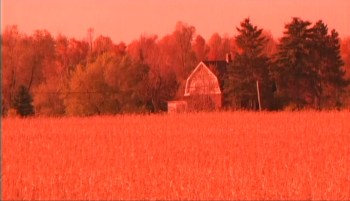
The fields turn a blood red
The film displays genuine respect for the black slaves of the past by depicting them with dignity and humanity. For example, rather than taking a more generic approach, which would have depicted the ghost slaves as menacing or zombie-like, Spurrell eschews traditional ‘monster’ makeup entirely, representing them as a noble people, dressed in clean period clothes, handsomely cast, and often filmed in slight low angle to give them a sense of empowerment (rather than the far more angled shots of the other characters which give them a sense of menace).
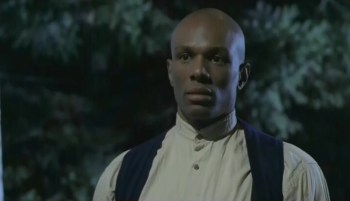
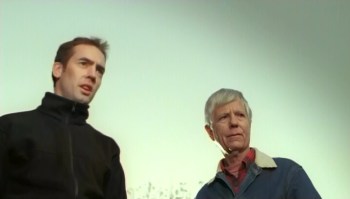
Even their method of moral rectitude is tasteful. Rather than violent vengeance, the ghost slaves re-enact an act of dehumanization seen in an old family photograph, where we see James’ young mother sitting on the back of a slave (Julius) treating him as if he were a horse or a dog. A similarly aged black ghost girl straddles onto Maurice’s back and rides him like a horse –an act which humiliates Maurice, but keeps him alive. After their act of retribution, the slaves turn to walk back to the cornfields. Spurrell adds a nice touch by having a bloodied wound (made from a scythe, another key prop) visible on the right back of each ghost (a literal and figurative mark which uncannily invokes the leather patches on the quilt).
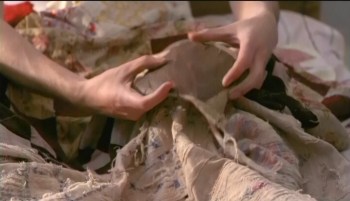
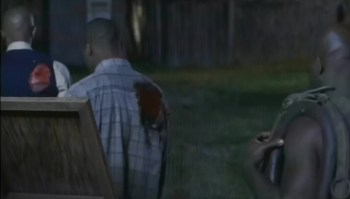
Graphic match between the quilt’s leather patch and the wounds
The film’s subtext also suggests a feminist angle. Although the female characters, counting James’ mother, who we only ever see as a young girl in the photograph, and his maternal grandmother Linda, are complicit with the racist past, they are depicted as positive characters through their implied resistance to the slavery, and their sympathetic attitude to the slaves (while Linda treats the slaves as humans, calling Julius by his name, Maurice refers to them as “bastards” and “animals”). When James leaves the farm, he acknowledges this with the warm hand embrace and smile he gives his grandmother, while avoiding eye contact with the grandfather. The implication being that these historical sins are largely due to patriarchy (and by extension capitalism).
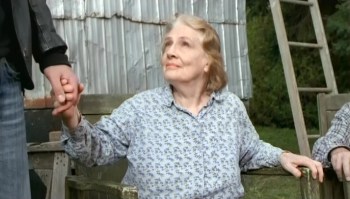
The sound design by Dan Lagacé and music by David Kristian are absolutely outstanding; it does not overwhelm you with recognizable themes, and the background sound effects are subtle yet induce the Mohawk effect, a term coined by special sound effects artist Ron Nagle explaining a sound effect used in The Exorcist that was meant to achieve the effect of raising the hair on the back of one’s neck.
For a film that was shot over the span of 5 years on a shoestring budget, the continuity is fluid and doesn’t betray the lack of funds. Philippe Spurrell has achieved a great deal with this film which has garnered interest across a broad spectrum of History and Film scholars, and the public at large (the film has already been sold to television and has aired on several occasions, but is still awaiting a proper DVD distribution). The film represents one of the best Quebec English Canadian films (yes they are distinct from the rest of English Canadian films) we’ve seen in a long while, functioning at the level of entertainment, while illuminating a forgotten part of Quebec’s local history.
An Interview with Philippe Spurrell
Bibliography
Remillard, Francois. Fabulous Quebec. Ulysses, Benoit Prieur, 2004.




